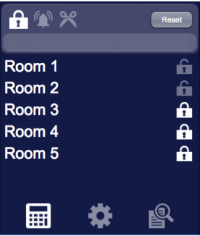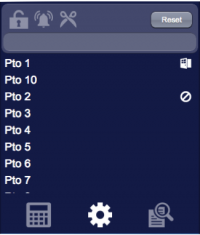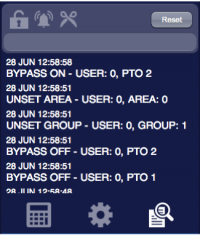Difference between revisions of "Inim"
| Line 74: | Line 74: | ||
|rowspan="3"| | |rowspan="3"| | ||
|515 | |515 | ||
| − | |the panel model to control. This option is required | + | |rowspan="3"|the panel model to control. This option is required |
|- | |- | ||
|1050 | |1050 | ||
|- | |- | ||
|10100 | |10100 | ||
| + | |||
| + | |- | ||
| + | |||
| + | |pin | ||
| + | | | ||
| + | |<nowiki><code></nowiki> | ||
| + | |use the specified user code to perform operations that require user authentication. If this option is not specified it will be required to manually insert the pin every time such operations are performed | ||
| + | |||
|} | |} | ||
Revision as of 13:41, 23 December 2013
Inim SmartLiving panels are multi-area intrusion detection systems. The integration with HSYCO can be accomplished via direct control through the RS-232 port on the board.
Contents
Communication
Employ a female-female RS-232 crossed cable to connect the panel directly to HSYCO or to an Ethernet/RS-232 gateway.
RS-232 parameters:
| Baud rate | 57600 |
| Data bits | 8 |
| Stop bit | 1 |
| Parity | none |
| Flow control | none |
HSYCO Configuration
Options
| ID | Default | Values | Description |
|---|---|---|---|
| gui | true | true | enable support for the UI object, UISET actions and USER commands |
| false | disable UI support | ||
| startupevents | false | true | generate IO events also during the driver’s start-up phase |
| false | start generating events only after HSYCO is aligned with the current status of the system | ||
| logsize | 50 | n ≥ 0 | the number of log lines to display in the UI object |
| pollinterval | 4 | n > 0 | the data acquisition interval, in seconds |
| mod | 515 | the panel model to control. This option is required | |
| 1050 | |||
| 10100 | |||
| pin | <code> | use the specified user code to perform operations that require user authentication. If this option is not specified it will be required to manually insert the pin every time such operations are performed |
inim.ini
The guardall.ini file is a specific configuration file located in the root directory. Here you can define the names of the groups so that they will be automatically added to the user interface. Add a new line for each group using this format:
<io_server_id>.group.<n> = <name>
For instance:
guard.group.1 = Kitchen guard.group.2 = Living room
Datapoints
| ID | Value | R/W | Description |
|---|---|---|---|
| connection | online | R | connection established |
| offline | R | HSYCO can't connect to the panel | |
| armed | 0 | R | all groups are disarmed |
| W | disarm all groups | ||
| 1 | R | the system is (partially) armed | |
| W | arm all groups | ||
| alarm | 0 | R | the system is not in a alarm state |
| 1 | R | the system is in a alarm state | |
| tamper | 0 | R | the system is not in a tamper state |
| 1 | R | the system is in a tamper state | |
| panel.tamper | 0 | R | the panel is not tampered |
| 1 | R | the panel is tampered | |
| bell.tamper | 0 | R | the bell is not tampered |
| 1 | R | the bell is tampered | |
| low.volts | 0 | R | voltage ok |
| 1 | R | low voltage detected | |
| sounder | 0 | R | the sounder is inactive |
| 1 | R | the sounder is active | |
| audio | 0 | R | the audio signal of the panel is inactive |
| 1 | R | the audio signal of the panel is active | |
| strobe | 0 | R | the strobe is inactive |
| 1 | R | the strobe is active | |
| mains.fail | 0 | R | no mains fail |
| 1 | R | mains fail | |
| power.fail | 0 | R | no power fail |
| 1 | R | power fail | |
| battery.fail | 0 | R | no battery fail |
| 1 | R | battery fail | |
| fuse.1.fault | 0 | R | fuse 1 is working |
| 1 | R | fuse 1 in fault | |
| fuse.2.fault | 0 | R | fuse 2 is working |
| 1 | R | fuse 2 in fault | |
| fuse.3.fault | 0 | R | fuse 3 is working |
| 1 | R | fuse 3 in fault | |
| line.fault | 0 | R | communication line is working |
| 1 | R | communication line in fault | |
| c<n>.name | <text> | R | the name of circuit <n> is set to <text> |
| g<n>.name | <text> | R | the name of group <n> is set to <text> |
| g<n>.armed | 0 | R | group <n> is disarmed |
| W | disarm group <n> | ||
| 1 | R | group <n> is armed | |
| W | arm group <n> | ||
| c<n>.alarm | 0 | R | circuit <n> is not in alarm state |
| 1 | R | circuit <n> is in alarm state | |
| c<n>.tamper.alarm | 0 | R | circuit <n> is not in tamper alarm |
| 1 | R | circuit <n> is in tamper alarm | |
| c<n>.open | 0 | R | circuit <n> is closed |
| 1 | R | circuit <n> is open | |
| c<n>.tamper | 0 | R | circuit <n> is not tampered |
| 1 | R | circuit <n> is tampered | |
| c<n>.fault | 0 | R | circuit <n> is working properly |
| 1 | R | circuit <n> is faulty | |
| c<n>.bypassed | 0 | R | circuit <n> is not bypassed |
| W | unbypass circuit <n> | ||
| 1 | R | circuit <n> is bypassed | |
| W | bypass circuit <n> | ||
| c<n>.isolated | 0 | R | circuit <n> is not isolated |
| W | un-isolate circuit <n> | ||
| 1 | R | circuit <n> is isolated | |
| W | isolate circuit <n> | ||
| c<n>.soaked | 0 | R | circuit <n> is not soaked |
| W | un-soak circuit <n> | ||
| 1 | R | circuit <n> is soaked | |
| W | soak circuit <n> | ||
| c<n>.status | <status_values> | R | the status of circuit <n> is set to the reported values |
| c<n>.attributes | <attributes_values> | R | the attributes of circuit <n> are set to the reported values |
| c<n>.resistance | <value> | R | the measured resistance on circuit <n> is <value> ohm |
| >20k | R | the measured resistance on circuit <n> is greater than 20 K-ohm | |
| k<n>.tamper | 0 | R | keypad <n> is not tampered |
| 1 | R | keypad <n> is tampered | |
| k<n>.fault | 0 | R | keypad <n> is working properly |
| 1 | R | keypad <n> is faulty | |
| logon.<n> | <user_num> | R | user with number <user_num> logged in from keypad <n> |
| error | R | wrong pin entered in keypad <n> | |
| system | reset | W | reset alarms |
| Circuit status values | |
|---|---|
| Value | Description |
| A | alarm/open |
| B | alarm/open and tamper |
| E | latched alarm and tamper |
| M | marginal clear |
| m | marginal alarm |
| N | normal |
| T | tamper |
| L | latched alarm |
| F | fault/no answer |
| X | Auxiliary alarm |
| Circuit attributes values | |
|---|---|
| Value | Description |
| B | bypassed circuit |
| I | isolated circuit |
| S | soak failed |
| T | soaked circuit |
| Y | temporarily bypassed circuit |
| Q | temporarily isolated circuit |
| H | circuit in shunt |
| A | existing circuit |
| M | multi-alarm |
| F | bank reset failed/door forced |
| L | locked |
| O | open |
Attributes can be combined together, for instance if a circuit is both isolated and bypassed, the attribute value will be “BI”.
User Interface
Guardall Object
The user interface for the Guardall multi-area intrusion detection system:
The Guardall object is listed in the Project Editor’s new object list only when at least one Guardall I/O Server is defined.
Parameters
- server id: the server ID
- position: the object's position. Use the pixels or rows and columns coordinates format
Syntax
(guardall <server id>; <position>)
E.g.
(guardall serverid; x10y20)
UISET Actions
| ID | Attribute | Set to | |
|---|---|---|---|
| log | value | latest security log lines (as many as specified by the 'logsize' option) | |
| log0 | value | latest line of the security log when a new entry is added, set back to blank after a short period | |
| c<n>.name | value | name assigned to circuit <n> or its number if no name is defined | |
| connection.label | visible | true | when datapoint connection = offline |
| false | when datapoint connection = online | ||
| <datapoint_id>.label.1 | visible | true | when datapoint with ID <datapoint_id> has value '1' |
| false | when datapoint with ID <datapoint_id> has value '0' | ||
| <datapoint_id>.label.0 | visible | true | when datapoint with ID <datapoint_id> has value '0' |
| false | when datapoint with ID <datapoint_id> has value '1' | ||
USER Commands
| Name | Param | Action |
|---|---|---|
| armed | 0 | disarm all groups |
| 1 | arm all groups | |
| g<n>.armed | 0 | disarm group <n> |
| 1 | arm group <n> | |
| c<n>.bypassed | 0 | unbypass zone <n> |
| 1 | bypass zone <n> | |
| c<n>.isolated | 0 | un-isolate zone <n> |
| 1 | isolate zone <n> | |
| c<n>.soaked | 0 | un-soak zone <n> |
| 1 | soak zone <n> | |
| system | reset | reset alarms |


